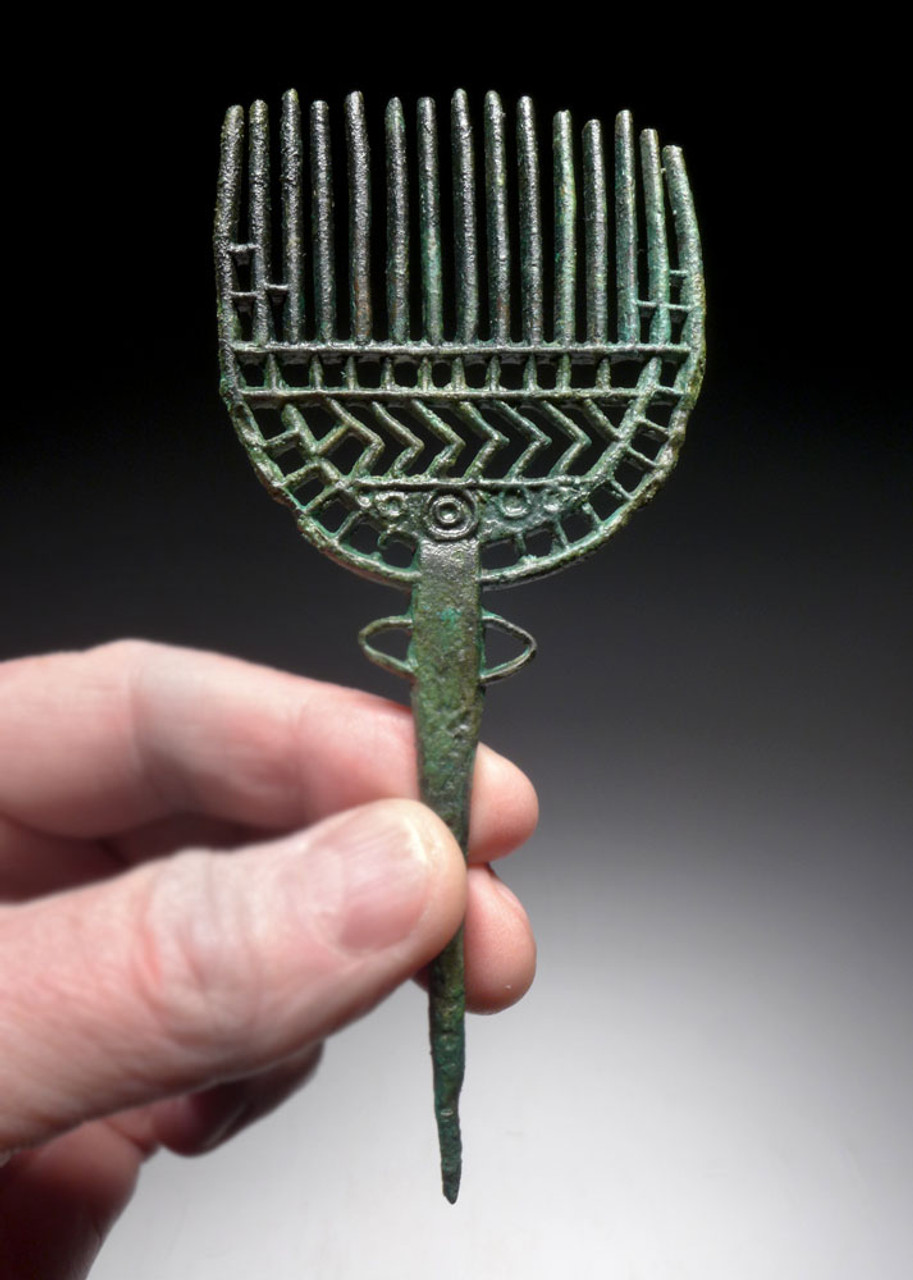Product Description
SEE MORE ANCIENT NEAR EASTERN ARTIFACTS
SEE MORE ANCIENT SCYTHIAN ARTIFACTS
Ancient eastern Saka Scythian antiquities are ULTRA-RARE and their absence in any collection, private or institutional, proves that. Objects of extreme wealth and status are the scarcest of ANY culture and this stunning piece offers an opportunity to acquire a rare wealth display object from this enigmatic ancient empire.
This is a complete bronze openwork stick comb pin of the eastern Scythians. The open intricate geometric design is made of numerous linear geometric designs in the delicate bronze rods. While a pin like this could have been used to comb a persons hair, since the Scythians literally lived on the back of the horse, this comb pin could have also been used to groom its owner's beloved horse. Pins of this intricate openwork design are unique to the ancient eastern Scythians. Objects like this represent the zenith of displays of wealth and nobility in this Bronze Age ancient society.
To the west, the ancient Iranian empire thrived during the same age and produced artistic large pins as well, but never with finely detailed open designs as this one displays. Some of these pins are purely geometric in their theme while some feature anthropomorphic creatures in the delicate wire designs. Some seem to be functional with a hair comb on the top. Because these pins are made by casting, it is common to see minor ancient manufacturing defects where the bronze never fully filled the mold. Even in today's metalsmithing workshops, fully casting an object like this would be quite difficult to achieve a perfect, complete cast. Because this pin would have been extremely difficult to make, it is quite a special prize object even by today's standard, as it was thousands of years ago
The bronze preservation of this pin is perfect! The alloy used was likely arsenical bronze which was an ancient alloy designed for increased strength and better molten performance in casting. Because of this, the typical corrosion seen on ancient bronze is not often seen on these, and this exquisite specimen is a fine example of that!
This artifact has been professionally cleaned and conserved in our lab, being treated with a special sealer developed and formulated by us specifically for ancient metal preservation. The patina shows beautiful traits only found in authentic ancient weapons. It is a patina like this that the finest ancient bronzes are prized for and it is a patina like this that brings a premium in price and value of the specimen. There is no active bronze disease. Bronze disease can develop on ancient bronze that is not properly cleaned and conserved. It produces a corrosive powder that will literally eat away an artifact over time and destroy it.
HISTORY
The Saka were a group of nomadic Iranian peoples who historically inhabited the northern and eastern Eurasian Steppe and the Tarim Basin. Though closely related, the Sakas different from the Scythians of the Pontic Steppe and the Massagetae of the Aral Sea region, though they all form part of the wider Scythian cultures. Like the Scythians, the Sakas were ultimately derived from the earlier Andronovo culture. The Sakas were a group of Iranic peoples who spoke a language belonging to the Iranian branch of the Indo-European languages. The Saka were racially Europoid.
Historical records and scientific studies date the Saka as early as the 8th century BC. In the Achaemenid-era,ancient Persian inscriptions found at Persepolis, dated to the reign of Darius I (r. 522-486 BC), record the Saka as having lived just beyond the borders of Sogdia. An inscription dated to the reign of Xerxes I (r. 486-465 BC) has them associated with the Dahae people of Central Asia.
In the 2nd century BC, many Sakas were driven by the Yuezhi from the steppe into Sogdia and Bactria and then to the northwest of the Indian subcontinent, where they were known as the Indo-Scythians. Other Sakas invaded the Parthian Empire, eventually settling in Sistan, while others may have migrated to the Dian Kingdom in Yunnan, China. In the Tarim Basin and Taklamakan Desert region of Northwest China, they settled in Khotan, Yarkand, Kashgar and other places, which were at various times vassals to greater powers, such as Han China and Tang China.
The art of the Saka was of a similar styles as other Iranian peoples of the steppes, which is referred to collectively as Scythian art. Ancient influences from Central Asia became identifiable in China following contacts of metropolitan China with nomadic western and northwestern border territories from the 8th century BC. The Chinese adopted the Scythian-style animal art of the steppes (descriptions of animals locked in combat), particularly the rectangular belt-plaques made of gold or bronze, and created their own versions in jade and steatite.
Following their expulsion by the Yuezhi, some Saka may also have migrated to the area of Yunnan in southern China. Saka warriors could also have served as mercenaries for the various kingdoms of ancient China. Excavations of the prehistoric art of the Dian civilisation of Yunnan have revealed hunting scenes of Caucasoid horsemen in Central Asian clothing.
 US DOLLAR
US DOLLAR
 EURO
EURO
 AUSTRALIAN DOLLAR
AUSTRALIAN DOLLAR
 CANADIAN DOLLAR
CANADIAN DOLLAR
 POUND STERLING
POUND STERLING
















